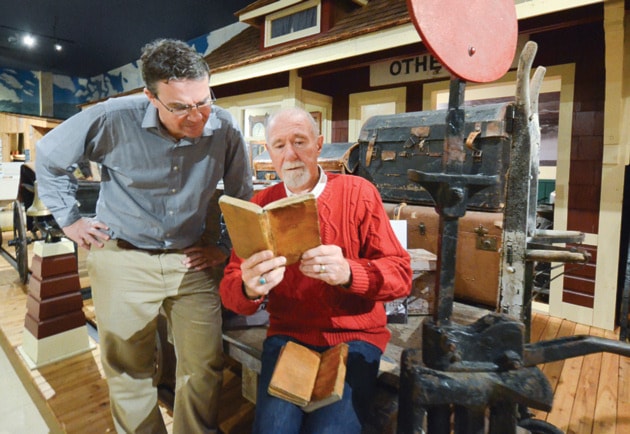Growing up in the 1930s the rail yards and hobo jungles were Bob Abbey’s playgrounds.
The youngest of seven children, Abbey’s father worked for Canadian Pacific Railway most of his life and not surprisingly coal was in his son’s blood as well.
As a young man, Abbey was the only one of the children who decided to follow in his dad’s footsteps, eventually finding his way to Penticton and a job with the Kettle Valley Railway.
So it was fitting Abbey joined members of the Myra Canyon Trestle Restoration Society (MCTRS) at a special donation by the group this week to the Penticton Museum and Archives.
The artifacts included 20 original volumes (starting in 1902) written by Andrew McCulloch who was the chief engineer for the Kettle Valley Railway during its construction from 1910 to 1917.
He stayed with the railway after its completion, until retiring in 1933. He died in 1945 at the age of 81.
“I worked for the KVR and for me the donation of this material is very important, it is a part of history,” said Abbey, 89. “My father was a railroader before I was born so personally for me it’s just a way of life, it is one of my very first memories and even now when I visit my youngest daughter in Spokane, (Wa.) when I hear that train whistle in the middle of the night it brings back all those memories.”
Making the donation to museum manager/curator Dennis Oomen was MCTRS member Maury Williams who is a history professor at the UBC Okanagan campus in Kelowna.
Williams is also the author of Myra’s Men: Building the Kettle Valley Railway Myra Canyon to Penticton, proceeds from which were used to help purchase the diaries from a private collector.
“We’re donating this to the museum because this is more or less the main repository for anything to do with the KVR and we’re happy that these are here,” said Williams. “From a Penticton point of view, without the KVR Penticton would just be a little community at the southern end of Okanagan Lake. Penticton’s reason for being is because it was the main headquarters for the Kettle Valley Railway.”
“We have a fascinations with railways and this was the hay day of the railway and from the Canadian history perspective the real establishment of Canada as a national country was done in the late 19th and 20th century through the transcontinental railway.”
He added another part of the historic importance of the documents is the fact the building of the railway with its 18 wooden trestles hundreds of feet above the valley floor, is the fact it kept this part of B.C. part of Canada.
“There was very serious concern that it would become part of the economic and political structure of the United States,” said Williams. “So by building the Kettle Valley line it made certain that the ties would be east-west rather than north-south and now to have the diaries about how that line was constructed adds immeasurably to our knowledge about how we got to be where we are.”
Oomen was particularly appreciative of the decision by the society to have the materials donated.
“This is a really significant donation for us,” he said. “Every archive wants to have the original documents and that’s what we’re getting here. We’re getting the notebooks carried around by McCulloch as he worked on the KVR.
“If you know your history you can apply it to the future and we have the raw materials of history right here.”
